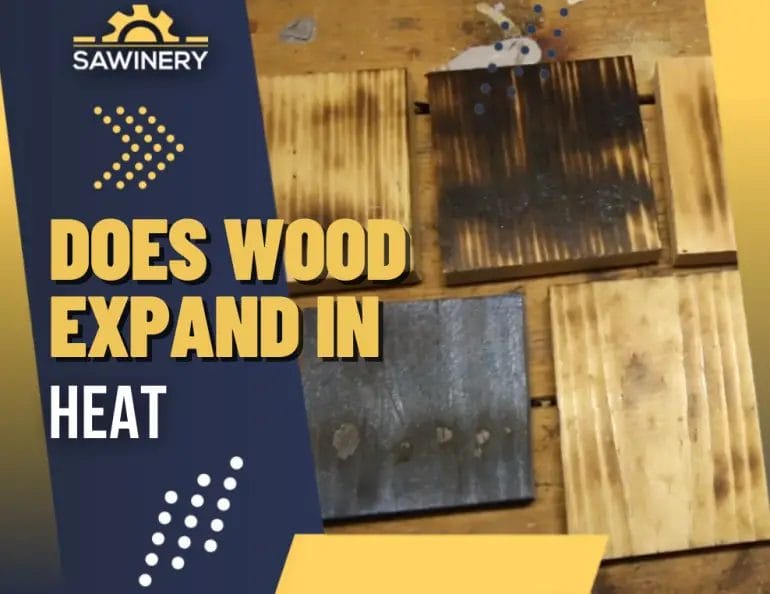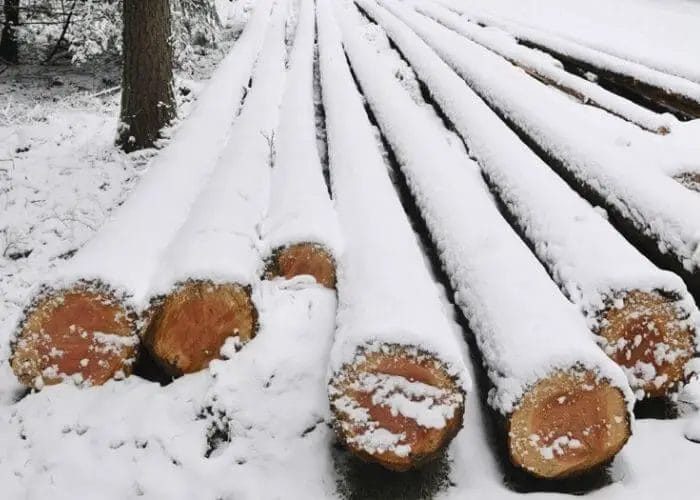Wood is a natural material that has the ability to expand and contract due to changes in temperature. When exposed to heat, wood expands as the heat causes its moisture content to increase. This expansion can lead to changes in the size and shape of wooden objects, such as doors, windows, and furniture.
Furthermore, the expansion of wood in the heat is an important consideration in construction and engineering projects. It is crucial to account for this natural behavior of wood to prevent any issues or structural damage that may arise from temperature fluctuations.


Factors Affecting Wood Expansion in High Temperatures
Wood is a versatile and widely used material in various industries, including construction, furniture making, and interior design. However, one of the challenges associated with wood is its tendency to expand and contract when exposed to high temperatures. Understanding the factors that influence wood expansion in high temperatures is essential to ensure the durability and stability of wooden structures.
1. Moisture Content
Moisture content is a critical factor that affects the expansion of wood in high temperatures. Wood is a hygroscopic material, meaning it can absorb and release moisture from the surrounding environment. As temperature increases, moisture trapped within the wood starts to evaporate, causing the wood fibers to shrink. Conversely, when exposed to high humidity, wood absorbs moisture, leading to expansion. This expansion and contraction due to moisture content directly affect wood’s dimensional stability when exposed to high temperatures.
2. Wood Species
Different wood species exhibit varying degrees of expansion and contraction in response to high temperatures. Softwoods, such as pine and spruce, typically have a higher coefficient of thermal expansion compared to hardwoods, like oak and mahogany. This difference is attributed to the structural composition and density of the wood. Therefore, when selecting wood for applications exposed to high temperatures, it is crucial to consider the specific species and its thermal expansion properties.
3. Grain Orientation
The grain orientation of wood also plays a significant role in its expansion behavior under high temperatures. Wood is an anisotropic material, meaning its properties vary with different directions. Flat-sawn lumber, which has growth rings parallel to the face of the board, expands and contracts more significantly compared to quarter-sawn or vertical-grain lumber. This is because the movement of wood fibers is primarily along the direction of the growth rings. Therefore, considering the grain orientation when using wood in high-temperature environments can help minimize the potential for excessive expansion.
4. Initial Moisture Content
The initial moisture content of wood before exposure to high temperatures can influence its expansion behavior. Wood with higher initial moisture content tends to undergo more significant expansion when heated due to the larger amount of moisture available for evaporation. Therefore, proper drying techniques and pre-treatment of wood to achieve an appropriate moisture content before installation or use in high-temperature settings are crucial to minimize expansion-related issues.
5. Structural Design and Restraints
The structural design and restraints imposed on wood in high-temperature environments can impact its expansion characteristics. For example, when wood is tightly constrained or fixed in a specific position, it may not be able to freely expand or contract with temperature changes. This can result in increased stress within the wood, leading to warping, cracking, or even structural failure. Therefore, allowing proper movement and incorporating expansion joints or gaps in wood structures exposed to high temperatures is essential to accommodate thermal expansion and prevent damage.
6. Temperature Differential
The temperature differential or the rate of temperature change in high-temperature environments can also affect wood expansion. Rapid temperature changes can induce thermal shocks, causing wood to expand or contract abruptly. This can put additional stress on the wood fibers, increasing the risk of deformation or damage. Careful consideration of temperature differentials and implementing insulation or heat-resistant materials can help mitigate the effects of rapid temperature changes on wood.
In summary, several factors influence wood expansion in high temperatures. These include moisture content, wood species, grain orientation, initial moisture content, structural design, restraints, and temperature differentials. By considering these factors and implementing appropriate measures, such as moisture control, proper wood selection, grain orientation optimization, and structural design considerations, the adverse effects of wood expansion in high temperatures can be minimized. This ensures the longevity and performance of wooden structures in various applications.

How Heat Impacts the Structure and Size of Wood
Wood is a versatile and widely used material that has been utilized by humans for thousands of years. From construction to furniture making, wood plays a crucial role in various industries. However, it is essential to understand how external factors, such as heat, can impact the structure and size of wood.
When exposed to heat, wood undergoes several changes that can affect its physical properties. These changes occur due to the evaporation of moisture present in the wood and the degradation of its organic compounds.
1. Thermal Expansion
One of the primary effects of heat on wood is thermal expansion. As wood is heated, the molecules within it gain energy, causing them to move more rapidly. This increased movement leads to the expansion of the wood’s structure. The extent of expansion depends on the type of wood and the temperature to which it is exposed.
Thermal expansion can have significant implications in various applications. For instance, in construction, when wood is used for flooring or decking, exposure to high temperatures can cause the wood to expand, leading to buckling or warping. It is crucial to account for this expansion when designing and installing wood in such situations.
2. Moisture Evaporation
Heat also affects the moisture content within wood. As the temperature increases, the heat causes the moisture present in the wood to evaporate. This evaporation can lead to drying and shrinking of the wood. The rate of moisture evaporation depends on the temperature and humidity levels in the surrounding environment.
Moisture evaporation can have both positive and negative impacts on wood. On one hand, it can help in reducing the weight of the wood, making it more suitable for certain applications. On the other hand, excessive drying can lead to cracking, warping, or loss of structural integrity.
3. Chemical Changes
Under high temperatures, the organic compounds within wood undergo chemical changes. This process, known as thermal degradation, can alter the structure and composition of wood. It can lead to the breakdown of complex organic molecules, resulting in the formation of volatile compounds and charred residues.
Chemical changes due to heat can impact the strength, durability, and combustibility of wood. In some cases, excessive heat exposure can weaken the wood, making it more prone to damage and decay. Understanding the chemical changes that occur in wood under heat is crucial for choosing the right wood for specific applications.
4. Fire Resistance
Wood is known for its flammability, but heat can also enhance its fire resistance. When exposed to high temperatures for a prolonged period, wood can undergo a process called pyrolysis. Pyrolysis involves the decomposition of wood in the absence of oxygen, resulting in the formation of a layer of charred material that acts as a barrier against further combustion.
The fire resistance of wood can be improved through various treatments, such as fire-retardant coatings or impregnation with fire-resistant chemicals. These treatments can minimize the impact of heat on the wood’s structure and size, making it more suitable for applications where fire safety is a concern.
Summary
Heat has a significant impact on the structure and size of wood. It causes thermal expansion, evaporation of moisture, chemical changes, and can also enhance fire resistance. Understanding these effects is crucial for utilizing wood effectively in various applications, from construction to furniture making. By considering the impact of heat on wood, we can ensure the durability, stability, and safety of wood-based products.

Preventing Damage: Tips for Dealing with Wood Expansion in Heat
In areas with hot climates or during the summer months, wood expansion due to heat can cause significant damage to wooden structures. Understanding how heat affects wood and implementing preventative measures can help preserve the integrity of your wooden furniture, flooring, and other wooden items. In this section, we will discuss some useful tips for dealing with wood expansion in heat.
1. Allow for Proper Air Circulation
One effective way to prevent wood expansion in heat is to ensure proper air circulation around the wooden items. Proper ventilation can help regulate the temperature and humidity levels, minimizing the risk of excessive heat-related expansion. Ensure that your wooden furniture, flooring, and other items are not placed directly against walls or in areas with limited airflow.
2. Use Moisture Barriers
Moisture barriers, such as sealants or coatings, can help protect wood from absorbing excess moisture and expanding in heat. Applying a moisture barrier to wooden surfaces can create a protective layer that reduces the impact of heat and humidity on the wood. Consult with a professional to determine the most suitable moisture barrier for your specific wooden items.
3. Maintain Optimal Humidity Levels
Controlling humidity levels can play a crucial role in preventing wood expansion. Use dehumidifiers or humidifiers to maintain the optimal humidity level in your indoor spaces. This can help minimize the moisture content in the air and prevent excessive wood expansion due to heat.
4. Avoid Direct Sunlight Exposure
Direct sunlight can significantly increase the temperature of wooden surfaces, leading to rapid expansion. Whenever possible, position your wooden furniture or items away from direct sunlight or use protective coverings, such as curtains or blinds, to block the sun’s rays. This can help reduce heat absorption and minimize wood expansion.
5. Regular Maintenance and Inspection
Regularly inspecting your wooden items can help identify early signs of expansion or damage. Promptly address any issues by consulting a professional to prevent further damage. Additionally, regular maintenance, such as sanding and refinishing, can help maintain the integrity of the wood and reduce the risk of expansion due to heat.
6. Choose Suitable Wood Types
When selecting wooden furniture or flooring, consider the type of wood that is less prone to heat-related expansion. Some wood species, such as oak or teak, are known for their stability and resistance to temperature changes. Consulting with a knowledgeable supplier or carpenter can help you choose the most suitable wood type for your specific needs.
7. Acclimatize Wood before Installation
If you are installing new wooden flooring or furniture, it is important to acclimatize the wood to its environment before the installation process. Allow the wood to adjust to the temperature and humidity of the space for a few days before installation. This can help minimize the chances of significant wood expansion later on.
In summary, wood expansion in heat can lead to damage and distortion of wooden items. By implementing preventive measures such as proper air circulation, using moisture barriers, maintaining optimal humidity levels, avoiding direct sunlight exposure, regular maintenance and inspection, choosing suitable wood types, and acclimatizing wood before installation, you can effectively deal with wood expansion and protect the integrity of your wooden items.
Common Problems and Solutions Related to Wood Expansion in Hot Environments
Wood is a versatile and widely used material in construction and furniture making. However, it is not without its challenges, particularly when exposed to hot environments. In this section, we will explore some of the common problems associated with wood expansion in hot conditions and discuss effective solutions to mitigate these issues.
1. Dimensional Changes
Wood is known to expand and contract with changes in temperature and humidity. In hot environments, the high temperatures can cause the wood to expand, leading to dimensional changes such as warping, bowing, and cupping. This can result in structural instability and aesthetic issues.
To prevent excessive dimensional changes, it is important to properly acclimate the wood before installation. This involves storing the wood in the environment where it will be used for a certain period of time, allowing it to adjust to the temperature and humidity levels. Additionally, using properly seasoned and kiln-dried wood can help minimize the extent of dimensional changes.
2. Joint Failure
In hot environments, the expansion of wood can put stress on joints, leading to joint failure. This can be a significant concern in furniture or cabinetry where strong and durable joints are essential.
To address this issue, it is crucial to use appropriate joinery techniques that allow for wood movement. Techniques such as mortise and tenon, tongue and groove, and floating panels can accommodate the expansion and contraction of wood without compromising the integrity of the joints. Additionally, using adhesives that are specifically designed for wood movement can help prevent joint failure.
3. Surface Cracking and Checking
High temperatures can cause rapid drying of the wood, leading to surface cracking and checking. This can not only affect the aesthetics of the wood but also compromise its structural integrity.
To minimize the occurrence of surface cracking, it is essential to apply a protective finish to the wood. Finishes such as varnish, lacquer, or oil-based products can provide a barrier, reducing the rate of moisture loss from the wood. Regular maintenance and reapplication of the finish can help further protect the wood from drying out and cracking.
4. Moisture Imbalance
In hot environments, wood tends to lose moisture, leading to an imbalance in moisture content. This can result in uneven expansion and contraction within the wood, leading to warping and twisting.
To maintain a moisture balance in wood, it is important to control the humidity levels in the environment. Using humidifiers or dehumidifiers can help regulate the moisture content, preventing excessive wood movement. Additionally, sealing the wood with a moisture-resistant sealant or paint can help minimize moisture exchange with the surrounding environment.
5. Heat Damage
Prolonged exposure to high temperatures can cause heat damage to wood, such as scorching or discoloration. This can be a concern in outdoor applications or near heat sources in indoor environments.
To protect wood from heat damage, it is advisable to provide adequate insulation or shielding. Using heat-resistant materials as barriers or placing heat-reflective surfaces can help reduce the direct impact of high temperatures on the wood. Additionally, positioning the wood away from direct heat sources can minimize the risk of heat-related issues.
In summary, wood expansion in hot environments can lead to various problems such as dimensional changes, joint failure, surface cracking, moisture imbalance, and heat damage. However, by following appropriate techniques and implementing effective solutions, these issues can be mitigated. Proper acclimation, careful joint design, application of protective finishes, moisture control, and heat insulation are all essential in ensuring the longevity and performance of wood in hot environments.
FAQs
Does wood expand in the heat?
Yes, wood does expand in the heat. When exposed to higher temperatures, the molecules within the wood start to vibrate and move more, causing the wood to expand. This expansion can lead to warping or cracking of the wood if it is not properly treated or engineered to handle the changes in temperature.
Conclusion
In conclusion, wood does indeed expand in the heat. This natural phenomenon occurs due to the increase in molecular activity within the wood fibers when exposed to higher temperatures. As the heat energy is absorbed, the wood molecules vibrate and move more vigorously, causing the material to expand. This expansion can lead to various consequences, such as warping, cracking, or splitting of wooden structures. Therefore, when working with or designing wooden objects, it is crucial to consider the potential expansion and plan accordingly to ensure the integrity and longevity of the wood.